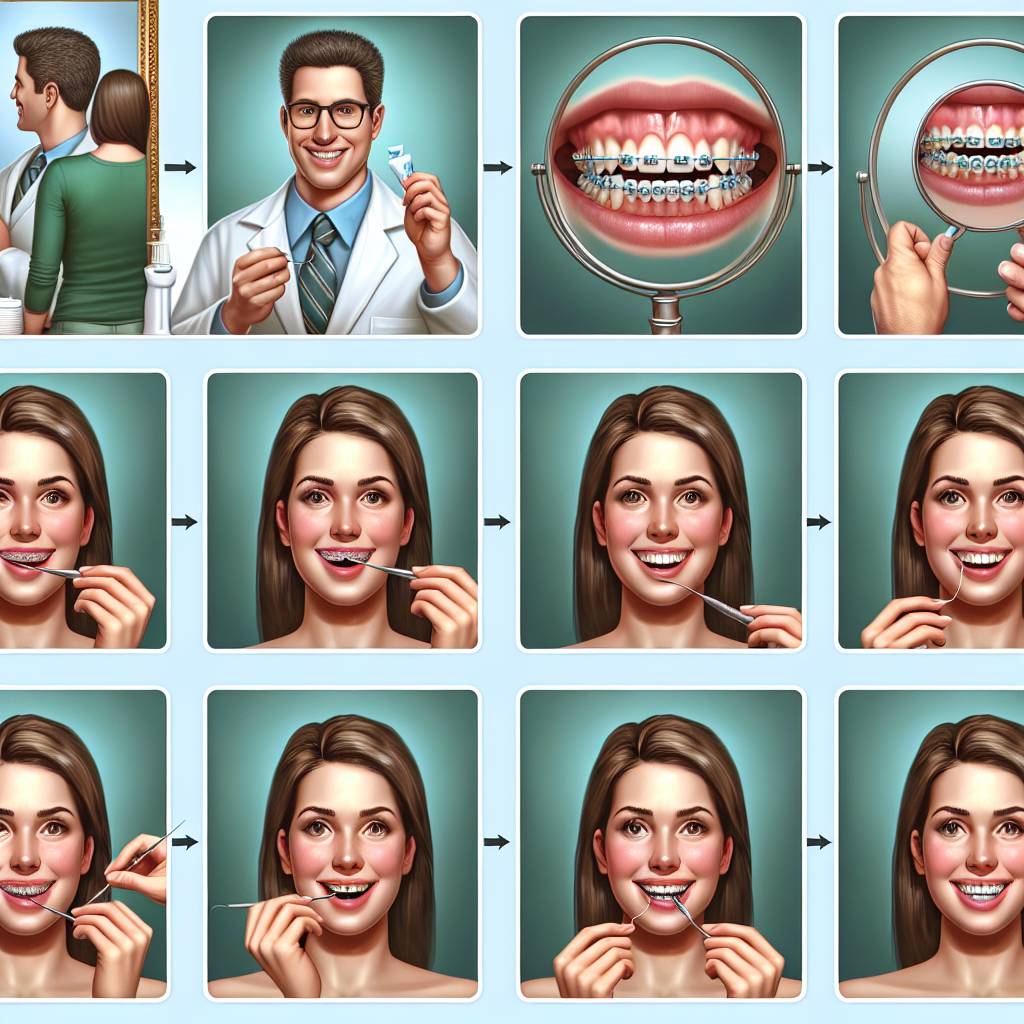Having a gap in your front teeth can be embarrassing, but it doesn’t have to be. There are several ways to fix the gap in your front teeth, depending on the severity of the gap and how you want the end result to look. Whether you opt for a simple home remedy or professional dental treatment, there are ways to close that gap and get your confidence back. In this article, we’ll discuss what you can do to close the gap in your front teeth so you can feel great about your smile again.If you have a gap in your front teeth, there are several ways to fix it. The most common method is through the use of dental bonding. This is a procedure in which a tooth-colored composite is applied to the tooth and then hardened with a special light. The composite material will fill in the gap and give your teeth a more natural appearance.
Another option is to use veneers, which are thin shells made of porcelain or composite that are placed over the teeth. Veneers can be used to close gaps or cover stained and chipped teeth.
If you have more severe damage or gaps, your dentist may suggest porcelain crowns, bridges, or implants. These solutions involve reshaping the teeth, adding extra material, or replacing missing teeth altogether.
No matter which option you choose, it’s important to consult with your dentist so they can determine what’s best for your specific situation.
What Are the Options to Close a Gap in Teeth?
Having a gap in between your teeth can be an embarrassing and confidence-shattering experience. Fortunately, there are several options available for closing the gap in your teeth, some of which involve minimal procedures. It is important to understand the available options and their associated costs so that you can make an informed decision about how you want to close the gap in your teeth.
One of the most popular options for closing gaps between teeth is dental bonding. Dental bonding is a procedure wherein a dentist uses a special composite material to close the gap by bonding it directly to the existing tooth structure. This procedure is relatively quick and painless, with most patients reporting only minor discomfort during treatment. The results of dental bonding are also immediate, so you won’t have to wait for weeks or months before seeing results.
Another option for closing gaps between teeth is dental veneers. Dental veneers are thin shells of porcelain or composite material that are bonded directly to the front surface of each tooth. They not only close gaps between teeth but also improve their overall appearance by covering any discoloration or damage. Veneers are permanent and usually last up to 10 years with proper care and maintenance.
Invisalign is another popular option for closing gaps between teeth without traditional braces. Invisalign uses clear plastic aligners that gradually move your teeth into place over time, while also closing any gaps in your smile. Invisalign is comfortable, removable, and nearly invisible when worn, making it an ideal choice for those who want to close gaps without having metal braces. The cost and duration of treatment will vary depending on your individual needs, but it typically takes about one year from start to finish with Invisalign treatment.
Finally, if you have large gaps in your teeth that require more extensive treatment than dental bonding or veneers can provide, you may need orthodontic treatment with traditional braces or clear aligners such as Invisalign Clear+. Orthodontic treatment requires more time and money than other methods of closing gaps between teeth but can produce impressive results if done correctly by an experienced orthodontist.
No matter which option you choose for closing the gap in your teeth, it’s important to consult with your dentist about what’s best for you and discuss any questions or concerns you may have before beginning treatment. With so many available options these days, there’s no reason why anyone should feel embarrassed or self-conscious about their smile anymore!
How Much Does It Cost to Close a Gap in Front Teeth?
The cost of closing a gap in front teeth will depend on the type of procedure that you choose. Treatment options for closing gaps in front teeth range from orthodontics to veneers and can range in cost from less than $1,000 to upwards of $4,000. Closing a gap in front teeth with braces is one of the most common and least expensive options, costing between $3,000 and $7,000. Veneers are another option for closing a gap in front teeth and can cost between $1,000 and $4,000 for each tooth. Invisalign is also an option, but it may be more expensive than braces or veneers. The exact cost of closing a gap in front teeth will depend on the type of treatment chosen and the complexity of the case.
It is important to speak with your dentist about your options before making any decisions about treatment. Your dentist can help you determine which type of procedure will best meet your needs and budget. Additionally, many dental insurance plans cover some or all of the costs associated with orthodontic treatment, so it is worth investigating if you have insurance coverage that could help reduce your out-of-pocket costs.
What Are Common Solutions for Closing Gaps in Front Teeth?
Closing gaps in front teeth can be achieved through a variety of dental treatments. Some of the most common solutions include braces, dental bonding, veneers, and crowns. Braces are the most traditional way to close gaps between teeth and are often used when the gap is too wide for bonding or veneers. They involve brackets being attached to each tooth and wires being used to gradually move them closer together. Dental bonding is a more cost-effective option that uses a composite resin material to fill in the gap between teeth. Veneers are thin ceramic shells that are applied to the front of each tooth to close the gap. Finally, crowns can also be used when there is significant damage to one or more of the teeth involved in the gap. These are porcelain caps that fit over the damaged tooth, closing any gaps along with it.
No matter which solution you choose, it’s important to consult with your dentist before making a decision. He or she can recommend which option would be best for your particular case and provide more information on how it will work and what results you can expect.
Is It Possible to Fix a Gap In Front Teeth Without Braces?
Yes, it is possible to fix a gap in front teeth without braces. There are various dental treatments available that can help close the gap between teeth without the use of braces. Some of these treatments include dental bonding, veneers, and dental implants.
Dental bonding is a procedure done by applying a composite resin material to the teeth. The material is then molded and shaped to close the gap between the teeth. This treatment is usually done in one visit and it requires no anesthesia. Dental bonding will not last as long as other treatments but it is very affordable and quick.
Veneers are thin shells made out of porcelain that are placed on top of teeth to cover any flaws or gaps between them. Veneers are durable and will last for several years with proper care. They are more expensive than dental bonding but they provide a natural-looking smile that can last for many years.
Dental implants are permanent tooth replacements that replace missing or damaged teeth with artificial ones. Implants look and function like natural teeth and they can be used to fill in gaps between existing teeth or replace missing front teeth entirely. Dental implants require surgery, so they usually take more time than other treatments, but they offer a permanent solution with minimal maintenance required over time.
In conclusion, there are various ways to close gaps in front teeth without braces, such as dental bonding, veneers, and dental implants. Depending on your preferences and budget, you should discuss all your options with your dentist to determine which treatment is best for you.

The Benefits of Closing the Gap In Your Front Teeth
Closing the gap between your front teeth has both cosmetic and functional benefits. From an aesthetic point of view, having straighter teeth can improve your smile, boost your confidence, and make you more attractive. On the practical side, a gap between your front teeth can make it more difficult to properly chew food and can eventually lead to dental problems like misalignment and tooth decay. Here are some of the main advantages to closing a gap in the front teeth:
Improved Appearance
The most obvious benefit of closing a gap between your front teeth is that it can dramatically improve the appearance of your smile. The combination of straighter teeth, a symmetrical bite, and a full set of pearly whites gives you a confident smile that will draw compliments from friends and family. Closing this gap can also make it easier to maintain good oral hygiene since there are fewer hard-to-reach places for plaque to accumulate.
Easier Eating Habits
Having a gap in your front teeth can make it difficult to eat properly. Certain foods may be challenging to chew due to the size or shape of the gap. Additionally, gaps between the front teeth are prone to getting food stuck in them, which can lead to cavities and other dental problems over time. By closing this gap with orthodontic treatment or dental bonding, you’ll be able to enjoy all types of foods with ease.
Reduced Risk Of Injury
Gaps in the front teeth can also increase the risk of injury while playing sports or engaging in other physical activities. Without proper protection (such as wearing a mouthguard), it’s easy for an opposing player or object to come into contact with these exposed areas and cause damage. Closing this space eliminates one more potential source of injury.
In conclusion, there are many benefits associated with closing the gap between your front teeth. From improved aesthetics to better eating habits and reduced risk of injury, orthodontic treatment or dental bonding can help you achieve a healthier, better-looking smile that will last for years into the future.
Can I Close the Gap In My Own Teeth?
Closing the gap between your teeth is a common desire among many people, and fortunately there are a variety of ways to do this. The first step in closing the gap in your own teeth is to consult with your dentist or orthodontist to discuss the options available to you. Depending on the size of your gap, you may find that there are several treatments available.
One of the most popular treatments for closing gaps in teeth is braces. Orthodontic braces work by applying gentle pressure to gradually move teeth into their desired position. This process can take anywhere from six months to two years depending on how severe the gap is. Braces can help close gaps between both front and back teeth, although they may not be suitable for everyone.
Another option for closing gaps in your own teeth is dental bonding. This procedure involves using a resin material that is applied directly onto the surface of your existing tooth. It can be used to change the shape or size of a tooth, and it can also be used to close gaps between adjacent teeth. Dental bonding typically takes only one visit and lasts up to eight years if properly taken care of.
In some cases, it may be necessary to use veneers or crowns in order to close gaps in your own teeth. Veneers are porcelain shells that fit over existing teeth in order to change their shape or color, while crowns are caps that completely cover a tooth in order to protect it from further damage or decay. Both options require several visits and are more expensive than braces or dental bonding, but they can give longer lasting results than other treatments.
Finally, some people opt for natural remedies like oil pulling or dietary changes in order to close gaps between their own teeth. Oil pulling involves swishing oil inside your mouth for several minutes each day, while dietary changes focus on avoiding foods that contain sugar and starches which can cause further damage to your teeth and gums over time. While these methods are generally safe and effective, they may not be suitable for everyone depending on their individual needs and preferences.
No matter what method you choose for closing gaps in your own teeth, it’s important to make sure you follow all instructions provided by your dentist or orthodontist closely so you get the best possible results from treatment. With proper care and maintenance, you should be able enjoy straighter, healthier looking smiles for years to come!
Closing a Gap In The Front Teeth Permanent?
Closing a gap in the front teeth is a common dental problem that can be corrected with orthodontic treatments. Depending on the size and location of the gap, orthodontists can offer a variety of treatments that can help close the gap and give you a beautiful smile. The most common type of treatment for closing gaps in front teeth is braces, which can be used to gradually move the teeth into their proper positions. In some cases, dental crowns or veneers may also be used to cover up the gap and give you a more even smile.
The amount of time it takes to close a gap in front teeth will depend on the size of the gap and how much movement is needed to move the teeth into position. Generally speaking, braces are typically worn for one to two years before the desired results are achieved. However, some patients may require additional treatments or longer treatment times depending on their individual needs.
Once your orthodontic treatment has been completed, any gaps in your front teeth will remain closed permanently. As long as you practice good oral hygiene and visit your dentist regularly for checkups and cleanings, your smile should remain beautiful for many years to come. However, if you notice any changes in your bite or feel that something is not quite right after having your braces removed, it’s important to contact your dentist right away so they can examine your mouth and make any necessary adjustments if needed.
Overall, closing gaps in front teeth can be done permanently with proper orthodontic treatment and regular follow-up care from your dentist. With proper care and maintenance, you can enjoy a healthy and beautiful smile for many years to come!

Conclusion
Fixing the gap in your front teeth can be a great way to improve your confidence and enhance your smile. With modern orthodontic procedures like braces, veneers, and bonding, you can close the gap between your two front teeth in a few months. In some cases, it may even be possible to do it without any kind of dental intervention at all.
It’s important to remember that every situation is different and there are always risks associated with any kind of medical treatment. Speak with your dentist or orthodontist to find out which option is best for you and make sure you understand all the risks before making a decision.
At the end of the day, no matter what method you choose to fix the gap in your front teeth, it’s important that you feel comfortable and confident with your smile again. With patience and dedication, you can achieve a beautiful smile that will last for years to come.

